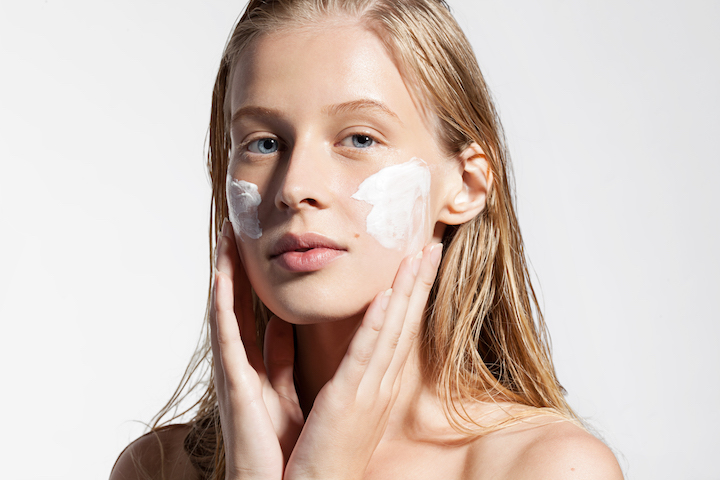Call them what you may: dark spots, sun spots, age spots, PIH. Hyperpigmentation sucks away your glow and just plain sucks. Here, the different types of hyperpigmentation and what you can do about it.
Gather ‘round children, for I shall tell the tale of a pesky skin issue that plagues a vast majority of us. It can cause people with even the best of skin to be self-conscious and is really, in not so precise terms, hella annoying. What is this plague, you ask? It’s hyperpigmentation.
But just what IS hyperpigmentation and why does it take so long to fade? How is it different from acne scarring or melasma? Let’s chat!
What is hyperpigmentation?
In simple terms, hyperpigmentation is basically an increase in melanin on the skin (aka, making your skin darker). What is melanin? It’s the pigment that gives us our skin and its color. If you’re darker skinned, you have more melanin, and if you’re a lighter skin tone, you have less melanin. Simple! Most hyperpigmentation covers small, specific areas of the skin. For today’s lesson, we’re going to focus on hyperpigmentation on the face.

Hyperpigmentation can be caused by a number of things: sun exposure, inflammation from eczema and psoriasis, acne, hormonal fluctuations, and our worst enemy, acne. Let’s delve deeper into some of these causes and how we can treat them!
Sun damage and sun spots
The number one cause of most hyperpigmentation is caused by sun exposure. You know how I’m always telling you in, like, literally every article I write that sunscreen is a non-negotiable? Well, I’m telling you again. SUNSCREEN IS A NON-NEGOTIABLE. Why? Well, our good friend in the sky (aka the sun) actually triggers the production of melanin in the first place. Ever heard of getting a tan? Yeah … that’s what’s happening there.
When you’re in the sun for an extended period of time, or you just don’t use sunscreen in general, the sun and its awful, terrible, no good UV rays do a number on your skin, causing it to produce extra melanin and, in turn, dark sun spots.

So the best step in avoiding sun damage is to be meticulous about your sunscreen and sunscreen application. You know how you never not wash your face? You need to be the same way about sunscreen!
If you already have sun spots, we’ll talk about treatments in a minute!
Post-inflammatory hyperpigmentation
Post-inflammatory hyperpigmentation (or PIH for short) is the type of hyperpigmentation that affects me the most. Like the name suggests, it’s hyperpigmentation that is caused after inflammation, namely acne, but also any cuts, scrapes, burns/chemical burns, over-exfoliating, psoriasis or eczema.
Basically, PIH is when your skin is healing from one of the above injuries and kinda glitches and makes too much melanin during the process. PIH can also be made worse by, yup, you guessed it, sun exposure. If you have PIH and you don’t use sunscreen, it’s only going to get darker because the sun makes us make melanin. It’s like the never-ending circle of life. It’s also why you don’t want to pick at your pimples. All of the picking and messing with it causes even more inflammation, which means that PIH is gonna come in full force after the acne heals. TeamNoPickingSkin all 2019, OK!

PIH commonly gets called acne scarring, but that’s not quite right. An acne scar is when you actually experience a loss of skin issue, which causes the skin to have a pitted or dimpled appearance. PIH is a temporary condition that can be improved with a topical treatment, whereas real acne scarring can only be improved with costly procedures such as dermabrasion, lasers, and in extreme cases, skin grafting. So, yeah, the two terms aren’t really interchangeable at all.
Melasma
Melasma is a super common form of hyperpigmentation, especially in darker skinned people. Instead of a dotted appearance like PIH, melasma typically forms in patches across the cheeks, forehead, around the mouth, and the chin. The vast majority of people who develop melasma are women, as it’s known to be related to hormonal changes due to pregnancy, birth control use, and other types of hormonal treatments.

Melasma is known to be a tad more difficult to treat, since it is caused by fluctuations in hormones, and not an external factor like PIH or sun damage. On top of that, melasma is also increased with sun exposure, so it’s like a double whammy.
What you can do about hyperpigmentation
Thankfully, hyperpigmentation is not difficult to treat. It responds well to typical over-the-counter treatments and SUN PROTECTION.
Listen. Do not read any further if you are not committed to using a sunscreen everyday. Protecting your skin from sun exposure is the first step in treating hyperpigmentation. There are a few sunscreens that I like, in no particular order:
1. Earth’s Recipe Waterful Sun Gel SPF 50+
2. So Natural Sebum Control Water Sun Gel
3. Blanc & Eclare Serein Essential Sun Cream

In the second line of defense is a good AHA treatment. AHAs work by sloughing off the dead skin cells on the surface of the skin. Over time, this causes the hyperpigmentation to fade. Over time are the keywords here — hyperpigmentation can take months to fade, even with consistent use of AHA and sun protection. On average, it takes about three months for my PIH to fade, and we all know I am about the skincare life.
Products like the ever-famous COSRX AHA Whitehead Liquid or a more intense treatment like the Eclado AHA Exfoliate Deep Peel are awesome choices. Other ingredients, like vitamin C, niacinamide, retinoids, and azelaic acid are also super effective against hyperpigmentation. I’ve found that for myself, using a diverse array of products (and sunscreen) are the best methods for fading PIH.
How do you treat your hyperpigmentation? Let me know in the comments!
Loading...